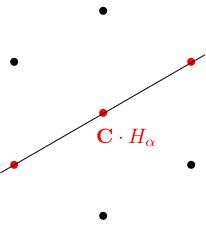All the root spaces are 1-dimensional.
Root spaces are 1-dimensional
Recap
If is the complexified Lie algebra of a compact semisimple group then where:
-
is the complexified Lie algebra of a maximal torus ,
-
is the root space corresponding to the root .
The figure below shows the root diagram of . We've been gradually discovering that various nice features of this Lie algebra and its root diagram carry over to root diagrams in this more general context. These nice features include:
If is a root then so is .
If and then , and span a subalgebra .
Partway through the proof of the previous point, we saw that , where is Killing-dual to . This depends on and only through their Killing pairing . We also saw that if we pick and suitably (so that ) then satisfies the commutation relations
In this video, we will show that:
Proof
Fix a root and consider the line through . We will sum some of the root spaces along this line:
-
over , we take the span of .
-
we take the root spaces , , etc and , etc, that is root spaces corresponding to integer multiples of .

The result is a subspace
is preserved by the action of the subalgebra . Moreover, it is irreducible as a representation of .
Irreducibility is the key thing, because this implies that the root spaces are all 1-dimensional.
We need to show that , and preserve . Let's just do (the others are similar/easier).
-
We have , so sends to something in .
-
We have because .
-
If we have and we're done.
-
If then , which is not contained in . In fact, we have , so we need to show that is a multiple of for any . But we saw that if and then , and is just a multiple of , so and we're done.
-
How do we see that this representation is irreducible? Let's understand the weight space decomposition of under the action of . I claim that is a weight space with weight for the action of .
This is because if , we have and, since , we have , but , so and has weight under the action of as required.
So our weight diagram looks like this: in weights respectively. In particular, the weight space with weight zero is , which is 1-dimensional. If we decompose into irreducibles then these irreducibles all have even highest weight (there are only even weights) and in particular they will all have 1-dimensional weight space in weight zero. But there is only room for one such irreducible piece, so must itself be irreducible.